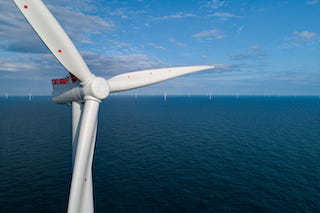Too slow deployment of grid upgrades and new storage technologies is costing Britain as much as £1billion a year in wasted renewable power, says a new report. The figure could rise to £3.5 billion by the 2030s, think tank Policy Exchange calculates
Diverting curtailed wind power from today’s overcrowded networks and using it to make green hydrogen are a short term remedy, the group’s new report recommends.
Research conducted by Policy Exchange with assistance from LCP Delta finds that in 2022 the volume of wasted wind generation was sufficient to produce over 118,000 tonnes of the green gas, rising to 455,000 tonnes by 2029.
Between 2021-22 congestion payments cost over £350 million. The report calls on Westminster to encourage electrolyser adoption in heavily curtailed areas to leverage this wasted energy and supercharge the UK’s nascent hydrogen economy.
Through modelling conducted with consultants LCP Delta, the report determines that electrolysing the UK’s wasted renewable energy could create enough hydrogen to:
- Take the place of two-thirds of Britain’s 700,000 tonnes of carbon-intensive grey hydrogen used each year;
- Decarbonise the entirety of the UK’s 7m tonne annual steel manufacturing;
- Meet over 90% of the government’s national Sustainable Aviation Fuel (SAF) target for 2030; or
- Deliver two thirds of our electrolyser production capacity target for 2030
Curtailing wind power is costly. Since 2021, LCP Delta estimate power system congestion has cost consumers over £2bn, and in 2022 alone some £210m of curtailment payments were made to renewable generators under contract.
Under annual price-fixing contracts for difference auctions promoting expansion, Britain’s wind fleet is set to grow from 14GW today to 50GW offshore by 2030, analyst Alex Simakov notes. Even with accelerated storage measures, the nation is on track for a fivefold increase in curtailment by 2030, wasting an amount of electricity equivalent to usage from more than five million households.
Measures now underway to ensure transmission capacity keeps pace include planned upgrade connections, siting of more storage assets, and the Review of Electricity Market Arrangements (REMA) regime designed to allocate upgrade costs fairly.
But Simakov worries such plans will take over a decade to fully materialise, and are expected to be outpaced by new power sources.
Britain nascent hydrogen economy could fill the gap, he believes. Between heavy industry, transport including sustainable aviation fuels, energy storage and other feedstocks, hydrogen is expected to deliver between a fifth and a third of Britain’s final energy consumption by 2050.
Even as the scale of its future role in decarbonisation remains unclear, hydrogen’s application for flexible power generation and long-duration storage will need to grow more than 100 times on current output.
While the majority of the UK’s economy can be decarbonised through electrification, low-carbon hydrogen must, says Policy Exchange, also play a major role in achieving net zero.
The sector still faces a chicken-or-egg dilemma, Simakov observes. Heavy upfront costs needed for hydrogen production and transport deter early movers and impose high marginal prices, while prospective end-users are reluctant to invest in hydrogen infrastructure.
Heavy diverting of investment into electroylising the green gas could take up much of the burden, Simakov recommends.
Read Policy Exchange’s report here.




